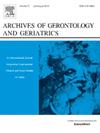Does life get better after middle age? Cultural comparisons of trends and key predictors of life satisfaction across the lifespan
IF 3.5
3区 医学
Q2 GERIATRICS & GERONTOLOGY
引用次数: 0
Abstract
Background
This study investigated 1) whether there are differences in the trajectory of life satisfaction (LS) across the lifespan between British and Indonesian adults, and 2) which factors are associated with LS overall, and according to culture and age.
Methods
1355 participants aged 18 to 91 were included: 649 British and 706 Indonesian. Participants completed an online questionnaire examining LS, quality of life (which included physical health, psychological wellbeing, social relationships, and environment), depression, anxiety, and religiosity. Data were examined looking at all participants within each culture and then by further separating each cultural group into three age groups (Young adults/YA (18-39), middle-aged/MA (40-59), older adults/OA (60+).
Results
The trajectory of LS across the lifespan was U-shaped in British participants but followed an inverted U-shaped pattern in Indonesian participants. Regression analyses on Indonesian and British participants (when all ages were grouped together) revealed that psychological well-being, social relationships, and environment were significantly associated with LS in both cultures, but LS was further impacted by other distinct factors in each group, such as anxiety and religiosity in Indonesian participants and depression in British participants. On analysing the age groups separately some of these predictors of LS were no longer significant, or were only applicable to specific age group(s) and/or one country.
Discussion
Psychological well-being, social relationships, and environment are important variables which should be incorporated into LS interventions for both cultures. Addressing the distinct needs of different cultures and age groups may further help when tailoring LS interventions for these different groups.
人到中年以后生活会变好吗?在整个生命周期中生活满意度趋势和关键预测因素的文化比较
本研究调查了英国和印尼成年人一生中生活满意度的轨迹是否存在差异,以及根据文化和年龄,哪些因素与生活满意度相关。方法纳入1355名年龄在18 ~ 91岁之间的受试者:英国649人,印度尼西亚706人。参与者完成了一份在线问卷,调查了LS、生活质量(包括身体健康、心理健康、社会关系和环境)、抑郁、焦虑和宗教信仰。对每个文化中的所有参与者进行数据检查,然后进一步将每个文化群体分为三个年龄组(年轻人/YA(18-39),中年人/MA(40-59),老年人/OA(60+)。结果英国人的寿命轨迹为u型,而印度尼西亚人的寿命轨迹为倒u型。对印尼和英国参与者的回归分析显示,两种文化的心理健康、社会关系和环境与LS显著相关,但每组中其他不同因素进一步影响LS,例如印度尼西亚参与者的焦虑和宗教信仰,以及英国参与者的抑郁。在单独分析年龄组时,LS的一些预测因素不再显著,或仅适用于特定年龄组和/或一个国家。心理健康、社会关系和环境是重要的变量,应纳入两种文化的LS干预措施。解决不同文化和年龄群体的独特需求可能进一步有助于为这些不同群体量身定制LS干预措施。
本文章由计算机程序翻译,如有差异,请以英文原文为准。
求助全文
约1分钟内获得全文
求助全文
来源期刊
CiteScore
7.30
自引率
5.00%
发文量
198
审稿时长
16 days
期刊介绍:
Archives of Gerontology and Geriatrics provides a medium for the publication of papers from the fields of experimental gerontology and clinical and social geriatrics. The principal aim of the journal is to facilitate the exchange of information between specialists in these three fields of gerontological research. Experimental papers dealing with the basic mechanisms of aging at molecular, cellular, tissue or organ levels will be published.
Clinical papers will be accepted if they provide sufficiently new information or are of fundamental importance for the knowledge of human aging. Purely descriptive clinical papers will be accepted only if the results permit further interpretation. Papers dealing with anti-aging pharmacological preparations in humans are welcome. Papers on the social aspects of geriatrics will be accepted if they are of general interest regarding the epidemiology of aging and the efficiency and working methods of the social organizations for the health care of the elderly.

 求助内容:
求助内容: 应助结果提醒方式:
应助结果提醒方式:


